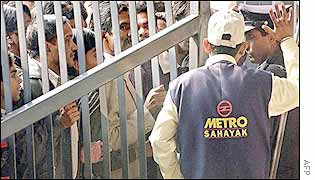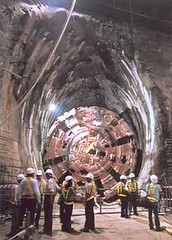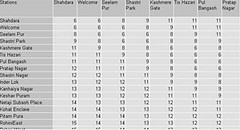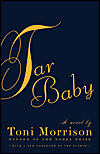Dilli Metro ... (Part 2)

When the Metro first opened, the crowds at the stations outnumbered an Amitabh first-day first-show opening in Allahabad. There was such a deluge of job applicants that the government set up web based recruitment results. That idea must have been a big hit - it continues to this day.
The libertarian in me would question the privacy implications of posting candidates names and medical examination dates online. But in a nation with a billion people, no social security numbers, and hundreds of Ramvir Singhs and Sudhir Kumars, that is armchair academia (I know, that expression is doubly-redundant). Besides, this beats queueing up for hours in front of poorly lit bulletin boards and jostling for a glimpse of your misspelt name on a dot-matrix printout with missing pins and re-re-recycled ribbons. Sigh - brings back old memories: board exam results lines longer than those at Aishwarya Rai’s wax replica at Madam Tussauds’ or end semester marksheet displays in the monkey-infested academic block at DCE.
But then, how many safai karamcharis will have access to the internet? There are about 234,000 internet users in Delhi according to Rightserve, out of a population of 15 million (1.6% penetration), so the numbers would be slim.
They run at intervals of 8 to 10 minutes from 6 a.m. to 10 p.m. The frequency of service and times of operation will be increased as the commuter traffic builds up. The system is designed to operate at a frequency of 3 minutes [Link]
 So if you’re into late night partying, look for a rickshaw or bus. Unless you’re a 16-year old girl. Or an 18 year old girl. Or any age, for that matter. On second thoughts, maybe the 10 p.m. deadline is not that bad.
So if you’re into late night partying, look for a rickshaw or bus. Unless you’re a 16-year old girl. Or an 18 year old girl. Or any age, for that matter. On second thoughts, maybe the 10 p.m. deadline is not that bad. Trains currently consist of 4 coaches - two driving coaches and two trailing coaches. However, the system is designed for trains with upto 8 coaches. Each coach has seating for 60 passengers, with space for another 325 standing passengers. [Link]Like many other civil projects, expansion was a design goal for the Metro project: current frequency 8-10 minutes, can handle 3 minutes; current coaches 4, can handle 8. However, just like many other civil projects, I feel that they underestimated the demand. Built-in expansion capacity = 4x to 5.3x. However, the current frequency is already down to 4 minutes on some lines [Link]. Also, Delhi’s population is growing at a rate of 3% p.a, mostly due to immigration.
According to a 2001 census by the Indian government, 13.0 million people lived in the Delhi metropolitan area. However, it is now estimated that more than 15.0 million people live in Delhi and its surrounding suburbs with migrants accounting for 60% of the increase in population [Link]
 Fares vary by distance, a smart move in India. New York Metro or Paris Metro style flat pricing would have caused lots of joyrides! Also, I found no evidence of the crippling student fares (popularly called “staff” discount) - concessions offered to Delhi University student unions who exploited the free ride policy for DTC employees. They claimed to be DTC employees/staff as well, usually by saying “staff” (hence the moniker) when a timid conductor would ask them to buy a ticket. Any hint of resistance or appeal to logic would lead to riots and beatings of said conductor.
Fares vary by distance, a smart move in India. New York Metro or Paris Metro style flat pricing would have caused lots of joyrides! Also, I found no evidence of the crippling student fares (popularly called “staff” discount) - concessions offered to Delhi University student unions who exploited the free ride policy for DTC employees. They claimed to be DTC employees/staff as well, usually by saying “staff” (hence the moniker) when a timid conductor would ask them to buy a ticket. Any hint of resistance or appeal to logic would lead to riots and beatings of said conductor.
Possibly breaking from the Public Transport Tradition of lossmaking (DTC, Indian Railways), the Metro seems to be making a handsome profit.
The Metro rail earned Rs 4.27 crore as passenger revenue between January and March ...and raised Rs 1.78 crore by inviting advertisements and renting out parking lots and shopping complexes... while the overall expenditure for running the trains stood at Rs 4.53 crore, Delhi Metro Rail Corporation (DMRC) Chairman Madan Lal Khurana told reporters. [Link]This is inspite of very reasonable fares. The price range is Rs. 6 - 22, compared to $3.00 on the NY Metro [Link] and $1.95 - $7.30 on the Chicago MetraRail [Link]. The initial ROI models for the Metro (in 1995) assumed a base rate of Rs. 5 per passenger trip of 7.12 km. Adjusting for 5% inflation over 11 years, that price should have been Rs. 8.55. Still, the Japanese should be happy with this investment (OECF Japan provided 56% of the project financing [Link]).

Electronic indicator boards show the destination
and time remaining for the next train arrival.
Heavy use is expected: a one-day tourist card @ Rs. 70 needs about 5 trips in a day to break even, as compared to an NY Metro Weekly pass @ $24 which allows a leisurely 8 trips over 7 days. The cards are contactless stored-value smartcards - better than NY tokens (now obsolete), or swipe-Metrocards-that-don’t-register-the-first-time. And tailoring to the desi mentality, the card requires a Rs. 100 refundable deposit (even on a Rs. 100 card!), unlike the free NY Metrocard.






Delhi Metro is really impressive, and your cliff's notes version of the inside story is great!
Posted by qsg |
9:51 PM EST ·
qsg |
9:51 PM EST ·